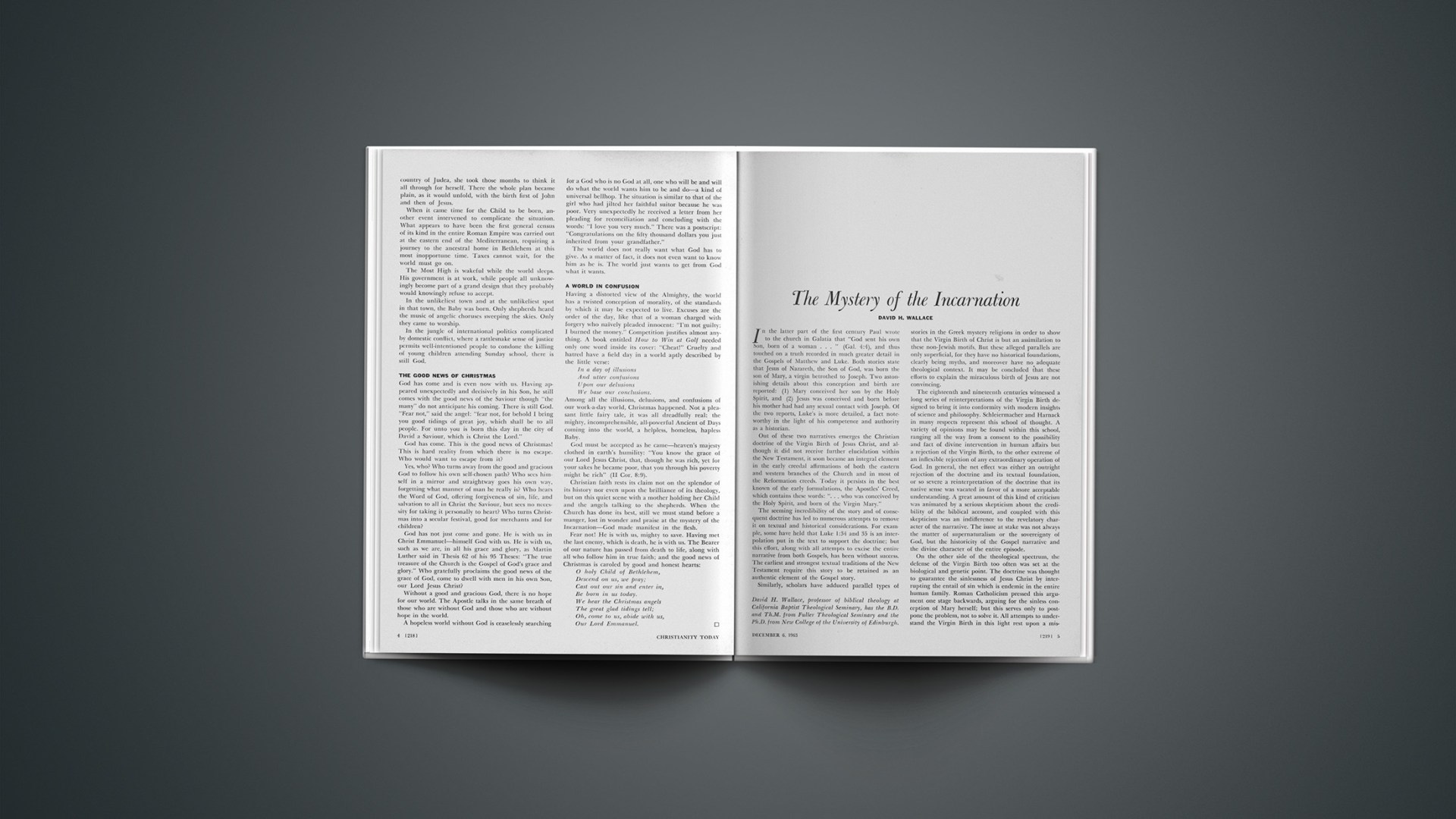In the latter part of the first century Paul wrote to the church in Galatia that “God sent his own Son, born of a woman …” (Gal. 4:4), and thus touched on a truth recorded in much greater detail in the Gospels of Matthew and Luke. Both stories state that Jesus of Nazareth, the Son of God, was born the son of Mary, a virgin betrothed to Joseph. Two astonishing details about this conception and birth are reported: (1) Mary conceived her son by the Holy Spirit, and (2) Jesus was conceived and born before his mother had had any sexual contact with Joseph. Of the two reports, Luke’s is more detailed, a fact noteworthy in the light of his competence and authority as a historian.
Out of these two narratives emerges the Christian doctrine of the Virgin Birth of Jesus Christ, and although it did not receive further elucidation within the New Testament, it soon became an integral element in the early creedal affirmations of both the eastern and western branches of the Church and in most of the Reformation creeds. Today it persists in the best known of the early formulations, the Apostles’ Creed, which contains these words: “… who was conceived by the Holy Spirit, and born of the Virgin Mary.”
The seeming incredibility of the story and of consequent doctrine has led to numerous attempts to remove it on textual and historical considerations. For example, some have held that Luke 1:34 and 35 is an interpolation put in the text to support the doctrine; but this effort, along with all attempts to excise the entire narrative from both Gospels, has been without success. The earliest and strongest textual traditions of the New Testament require this story to be retained as an authentic element of the Gospel story.
Similarly, scholars have adduced parallel types of stories in the Greek mystery religions in order to show that the Virgin Birth of Christ is but an assimilation to these non-Jewish motifs. But these alleged parallels are only superficial, for they have no historical foundations, clearly being myths, and moreover have no adequate theological context. It may be concluded that these efforts to explain the miraculous birth of Jesus are not convincing.
The eighteenth and nineteenth centuries witnessed a long series of reinterpretations of the Virgin Birth designed to bring it into conformity with modern insights of science and philosophy. Schleiermacher and Harnack in many respects represent this school of thought. A variety of opinions may be found within this school, ranging all the way from a consent to the possibility and fact of divine intervention in human affairs but a rejection of the Virgin Birth, to the other extreme of an inflexible rejection of any extraordinary operation of God. In general, the net effect was either an outright rejection of the doctrine and its textual foundation, or so severe a reinterpretation of the doctrine that its native sense was vacated in favor of a more acceptable understanding. A great amount of this kind of criticism was animated by a serious skepticism about the credibility of the biblical account, and coupled with this skepticism was an indifference to the revelatory character of the narrative. The issue at stake was not always the matter of supernaturalism or the sovereignty of God, but the historicity of the Gospel narrative and the divine character of the entire episode.
On the other side of the theological spectrum, the defense of the Virgin Birth too often was set at the biological and genetic point. The doctrine was thought to guarantee the sinlessness of Jesus Christ by interrupting the entail of sin which is endemic in the entire human family. Roman Catholicism pressed this argument one stage backwards, arguing for the sinless conception of Mary herself; but this serves only to postpone the problem, not to solve it. All attempts to understand the Virgin Birth in this light rest upon a misunderstanding of the basic theology involved, the erroneous assumption being made that a moral fact is to be explained in terms of physical considerations. Biology and genetics are irrelevant in a discussion of the divine-human origin of Jesus Christ. Too frequently this school of thought became preoccupied with the starting gun and therefore lost the race. However, it remains to the credit of this line of defense of the doctrine that it began with an attitude of belief in and commitment to the reliability and revelatory nature of the New Testament record.
A Work Of The Holy Spirit
Taking this same stance, it is not only possible but also necessary to look at the doctrine essentially in terms of revelation in order to arrive at a theology of the Virgin Birth that exists without recourse to the natural sciences or philosophy. At least three basic affirmations may be made in this direction. First, the Virgin Birth is the initial event in the life of Jesus Christ that is radically affected by the Holy Spirit. Luke slates with restraint but clarity that “the Holy Spirit will come upon” Mary, so that He is directly and solely responsible for this unique birth. At all critical points in the life and ministry of our Lord, the Spirit plays a key role. At the baptism the Holy Spirit descended upon the Son to empower him for the work which lay before him. Again, at the temptation the Spirit led Jesus into the desert to undergo trial at the hands of the devil. When Jesus preached his first sermon, he chose a prophecy of Isaiah to declare that “the Spirit of the Lord is upon me …” (Isa. 61:1; Luke 4:18), and in his ministry of healing he stated that it was by the Spirit of God that these things were done. Paul states that the Resurrection was a Spirit-designated indication that Jesus is the Son of God. Therefore, it may be said that the Incarnation in all its aspects is a work of the Holy Spirit.
Secondly, the Virgin Birth of Christ is to be understood as an eschatological sign of the advent of the Kingdom of God. It is God himself who is the author of the sign of this unique activity in the world, terminating the centuries of silence which seemed to suggest that God had withdrawn himself from men. But now this sign, first to Mary and then to the entire community of faith, pointed to the intervention of God, an intervention which signaled a new age, new blessings, new revelation, and a new relation with God. It is a sign of his own presence among men in the person of the Infant of Bethlehem. It is the first of many such signs in the life of Christ, and it is paralleled by the last miracle of his life, the Resurrection. So these two signs form the first and last of a series, all of which characterize the Incarnation. The Virgin Birth is the external sign of Emmanuel, God with us.
Thirdly, the Virgin Birth is a mystery which ultimately lies beyond the reach of human comprehension and analysis. Lecerf, the Reformed theologian, once wrote that “the presence of mystery is the footprint of the divine.” Because of the mysterious and divine quality of this strange birth, it is not open to substantiation or refutation by the natural sciences or historical investigation, although the New Testament preserves an apostolic tradition recorded with historical fidelity. It is a sovereign, free act of God himself, and it must finally be recognized on this consideration alone. As such it does not overturn the legitimate prerogatives and canons of history and science, but these cannot evaluate a claim of revelation. On the other hand, the affirmation of mystery must not be made in a capricious way that may lead to a premature silencing of discussion, for it is a human right to ask questions. It is also, however, a human responsibility to recognize genuine mystery in the activity of God. The mystery of the Virgin Birth is only a part of the larger mystery and incomprehensibility of the Incarnation of God in Christ.
It is immediately clear that the Virgin Birth has extensive implications for the doctrine of Christ. Some have taken this to mean that God was initially obligated to accomplish the Incarnation by this means, and had there been no Virgin Birth there could have been no true Incarnation and no Atonement. To such a school of thought the Virgin Birth is the foundation stone of the Christian faith. This grasp of the doctrine rises from an inadequate view of God, for it is impossible to declare in advance what he must do. Moreover, it is noteworthy that Paul constructs his Christology apart from any specific reference to the Virgin Birth; his emphasis falls upon Christ’s pre-existence, Incarnation, and exaltation. However, those who assert that Paul either knew nothing of this truth or scorned it if he did know it, may need to re-examine his prolonged association with Luke, his reserve about Jesus’ legal father Joseph, and the implications of Galatians 4:4 and 5. Similarly, the silence of John and Mark does not have to be understood as ignorance or rejection of the Virgin Birth: it is possible to read their Gospels as complementing the accounts found in Matthew and Luke. If there had been a conflict on this issue, it is strange that it never came to the surface, as did the conflict between Peter and Paul.
Not An Optional Doctrine
Sometimes the feeling against this dogma, or against those who affirm it, grows so intense that the feeling itself begins to assume the proportion of a dogma. Then others assert that the Virgin Birth represents an idea unacceptable to the modern mind, and that therefore Christians are not bound by it. This attitude becomes in its way a new kind of theological authority, but it lacks an adequate rationale. Those who in conscience cannot accept this account of the birth of Jesus Christ do well to pass by the matter in silence rather than oppose what the apostolic and historic Church has quite uniformly believed. While the New Testament nowhere sets forth this doctrine as a part of the kerygma (1 Cor. 15:3, 4), neither can it be successfully argued that it is some kind of an optional doctrine.
A positive assessment of the Virgin Birth regards it as a coherent, credible, and convincing element of the entire New Testament story about Jesus Christ. It offends nothing taught elsewhere in the New Testament, and it positively correlates the doctrine of the preexistence of Christ and his Incarnation. It is the task of theology not to spell out what God was obligated to do, but to understand what he did do in history for our salvation. In short, the Virgin Birth is appropriate to the doctrine of Christ.
The Virgin Birth is not the proof that Jesus Christ is the Son of God. Rather, he is the eternal Son of God from the beginning, and it is this truth and this mystery which require the Virgin Birth to be recognized as the mysterious operation of God. Jesus’ Sonship both explains and dignifies his miraculous conception and birth. The mystery of the Virgin Birth does not derive its strength from the miracle of this kind of birth, but the miracle derives from the eternal mystery of the Son, and the miracle serves as a sign to draw reverent and worshipful attention to the Infant of Bethlehem.
It is to the discredit and shame of the theological enterprise that this doctrine has so frequently become a battleground across which theologians have leveled cannonades and barrages of polemic shot and shell. What was revealed as a cause of praise has instead been too often debased to an issue of resentment and exclusion from personal fellowship. In the approach of the Advent season Christians will best uphold this doctrine by first recognizing it as an occasion of the highest praise to the God at the birth of whose Son the angelic hosts sang their great doxology. Indeed, joy, thanksgiving, and praise are the hallmark of the biblical account of the birth of Jesus of Nazareth. The response of Mary must be the response of the entire Church to the good news of the birth of the Christ-child, “My soul magnifies the Lord, and my spirit rejoices in God my Saviour.”
David H. Wallace, professor of biblical theology at California Baptist Theological Seminary, has the B.D. and Th.M. from Fuller Theological Seminary and the Ph.D. from New College of the University of Edinburgh.










